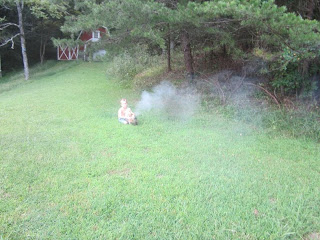
You know you've seen them alongside the road...just standing there with its branches weighed down from the sweet orbs waiting to be picked. We call these trees "orphans" because each season their fruit drops to the ground and is only enjoyed by the animals and bees. This time of year my family sees orphan fruit trees every where we go. Paul spies them usually before us because he doesn't have to concentrate on the twisty one-lane roads around here. It's easy to say, "Just knock on the homeowner's door and ask if you can pick their tree," but if you're like me, you may be a bit shy and fear the possible "NO!" Come to find out, every time we have asked to pick someone's tree, we have been told, "Oh please pick as many as you can!!" And more than one time we have been told, "I don't like those apples and we just mow over them...they are such a nuisance!" When you begin telling friends and neighbors that you preserve a lot of fruit and enjoy picking it, most likely they will recommend people who have excess to share. It's nice having others brings news of fruit to be picked without you doing all the leg work! My family has been picking orphan fruit trees and bushes for 6 years and here are some suggested guidelines we would like to share with readers:
1. Is the area contaminated? Don't pick next to a busy highway or a creek that receives storm water runoff.
2. Is the fruit area sprayed with fertilizers, pesticides, and Roundup? A quick glance at the grass and surrounding area will give you a good indication of this.
3. Is the fruit tree sprayed for pests? We have asked this question to homeowners and chances are if they don't eat the fruit, the tree isn't sprayed.
4. Are you sure no one wants the fruit? We do a few drive-byes to see if there is fruit lying on the ground rotting. Chances are if the fruit is constantly being picked up, the homeowner is using them. But you may want to ask anyway in the off-chance the fruit is being removed so bees aren't attracted to the rotting fruit.
5. If possible try not to bring a ladder. With so much hype about lawsuits these days, you don't want to scare a homeowner with the possibility that you may fall off and break something.
6. Offer the homeowner something in return for the fruit. Some people don't have the time and/or motivation to make a pie or applesauce but would love some in return for all the apples you take. Offering a service or other produce item in return is also thoughtful. In most cases I give a jar of applesauce and cider as a way of saying thanks. It also helps secure picking for next year! : )
This past week we picked 3 apple trees and even went back for seconds! The first tree was picked in a neighborhood and we made 6 attempts to contact the homeowner because they were never home when we stopped by. The persistence paid off and we hauled away a lot of apples!
These two trees were next to a church playground and behind a tanning salon. It took 5 phone calls to locate the owner of these trees. As tempting as it was to just go ahead and pick them without permission because they were off the main road, I didn't want to get caught for trespassing. Afterall, I want to make friends with these people so we can pick for many more years!
We don't know what variety the apples were but we really enjoyed them and may graft a branch this winter.
Paul likes to sample the apples!
To fit as much as we can in our small car we lined the trunk with a tarp. All together we filled 13, 5 gallon buckets for an estimated weight of about 300 pounds!
If you click the picture (for enlarging) you will still see the tree still full of apples. We went back for a second picking a few days later.
Paul is taking a peek at the apples in the trunk and finding the best one for sampling on the way home.
In one day we processed all of the apples: apple butter, apple sauce, apple cider, apple wine, apple pie, apple crisp, and dehydrated apples. The next batch of apples was made into cider vinegar, hard cider, pies, and more dehydrated apple slices. We are curious to see how long the apples will keep in our basement so we stored a couple dozen down there. Currently the basement is 64 degrees without an air conditioner and the main living area is 80 degrees.
Happy picking!










































